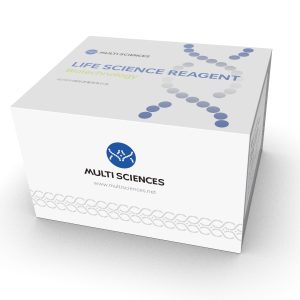HGNC ID: 6000
Target Abstract:
Interleukin-1 receptor antagonist (IL-1ra, also known as IL-1F3) is a member of the IL-1 cytokine family that includes IL-1α and IL-1β.IL-1ra inhibits the activity of interleukin-1 by binding to the IL-1R1 receptor and prevents it from binding to IL-1RAP, a co-receptor for signaling. Mouse interleukin-1 receptor antagonist (IL-1ra) is a 22-25 kda glycoprotein produced by a variety of cell types. Cells known to secrete IL-1ra include dermal fibroblasts, vascular smooth muscle cells, intestinal columnar epithelial cells, chondrocytes, macrophages, unkeratinized complex squamous epithelial cells, mast cells, neutrophils and monocytes, support cells, and hepatocytes.There are two types of type I transmembrane glycoprotein receptors for IL-1ra: the biologically active 80 kDa type I IL-1 receptor (IL-1 RI) and an inert 65 kDa type II IL-1 receptor (IL-1 RII).IL-1ra blocks the proinflammatory effects of IL-1, including the release of prostaglandin E2 and IL-6 from endothelial cells, fever, thrombocytosis, hepatic acute-phase protein production, and neutrophil expansion and infiltration.
IL1RN Target Infomation Overview
- Target Symbol: IL1RN, interleukin 1 receptor antagonist
- Gene Groups: Interleukins; Interleukin receptors
- Alias: IL1RA; ICIL-1RA; IL1F3; IRAP; IL-1RN; MGC10430
- Alias Names: interleukin-1 receptor antagonist protein; intracellular interleukin-1 receptor antagonist
IL1RN, interleukin 1 receptor antagonist Target Infomation by Species
- Human
- Mouse
- Rat
Human IL1RN Target Information
- Target Symbol: IL1RN, interleukin 1 receptor antagonist
- Alias:
- DIRA
- ICIL-1RA
- IL-1ra
- IL-1ra3
- IL-1RN
- IL1 inhibitor
- IL1F3
- IL1RA
- IL1RN (IL1F3)
- interleukin-1 receptor antagonist protein
- intracellular IL-1 receptor antagonist type II
- intracellular interleukin-1 receptor antagonist (icIL-1ra)
- IRAP
- MGC10430
- MVCD4
- type II interleukin-1 receptor antagonist
- NCBI_Gene: 3557
- UniProtKB: P18510
Human IL1RN Predicted Functions
Enables cytokine receptor binding activity. Involved in several processes, including acute-phase response; negative regulation of heterotypic cell-cell adhesion; and negative regulation of interleukin-1-mediated signaling pathway. Located in extracellular space. Implicated in several diseases, including autoimmune disease (multiple); eye disease (multiple); kidney failure (multiple); lung disease (multiple); and vascular disease (multiple). Biomarker of several diseases, including autoimmune disease (multiple); chronic kidney disease (multiple); glomerulonephritis (multiple); lung disease (multiple); and obesity (multiple).
Mouse Il1rn Target Information
- Target Symbol: Il1rn, interleukin 1 receptor antagonist
- Alias:
- F630041P17Rik
- IL-1ra
- RIKEN cDNA F630041P17 gene
- NCBI_Gene: 16181
Mouse Il1rn Predicted Functions
Predicted to enable cytokine receptor binding activity. Acts upstream of or within insulin secretion and lipid metabolic process. Located in extracellular region and vesicle. Human ortholog(s) of this gene implicated in several diseases, including autoimmune disease (multiple); eye disease (multiple); kidney failure (multiple); lung disease (multiple); and vascular disease (multiple). Orthologous to human IL1RN (interleukin 1 receptor antagonist).
Rat Il1rn Target Information
- Target Symbol: Il1rn, interleukin 1 receptor antagonist
- Alias:
- IL-1ra
- IL-1RN
- IL1 inhibitor
- interleukin 1 receptor antagonist gene
- interleukin-1 receptor antagonist protein
- IRAP
- NCBI_Gene: 60582
Rat Il1rn Predicted Functions
Enables interleukin-1 receptor binding activity. Involved in several processes, including cellular response to norepinephrine stimulus; chronic inflammatory response to antigenic stimulus; and fever generation. Located in extracellular space. Used to study adult respiratory distress syndrome; anti-basement membrane glomerulonephritis; hypertension; silicosis; and transient cerebral ischemia. Biomarker of encephalitis and pneumonia. Human ortholog(s) of this gene implicated in several diseases, including autoimmune disease (multiple); eye disease (multiple); kidney failure (multiple); lung disease (multiple); and vascular disease (multiple). Orthologous to human IL1RN (interleukin 1 receptor antagonist).

